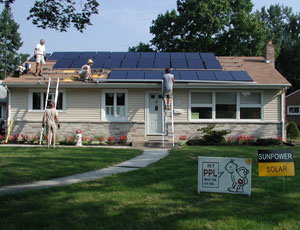Couple Earns First-of-Its-Kind Personal Carbon Credit
 It may not be much, but the balance in this Harrisburg couple’s PayPal account could signal a new era for homeowners trying to save energy.
It may not be much, but the balance in this Harrisburg couple’s PayPal account could signal a new era for homeowners trying to save energy.
A $21.50 transaction, and one company’s first $4.30 in revenue, could revolutionize “going green” for homeowners. Now, you can start pocketing some cash – even if it isn’t much, for the energy you conserve.
My Emissions Exchange has brokered what they are calling the first-ever sale of a personal carbon credit. The sellers, Tami and Randy Wilson of Harrisburg, Pa., expect a $17.20 PayPal payment soon. The broker will pocket a 20% commission, it’s first profit. “We don’t make money until credits are created and sold,” said Paul Herrgesell, project manager of My Emissions Exchange.
All the Wilsons had to do, in order to earn that $17.20, was invest $58,000 in a new solar power system for their home. While that might sound like extraordinary financial folly, consider this: A federal tax credit will cover nearly $18,000, and a Pennsylvania rebate check has already arrived for another $18,000. They could net as much as $2,700 in the first year selling renewable energy certificates, which they can continue to sell annually for as long as anyone will buy them. They expect to recoup their investment within six years. At that point, they’ll be spending nothing on electricity (they had spent $80-$120 a month) and they’ll still be earning money from their renewable energy certificates, which power companies buy to meet government mandates.
The carbon credit payment, then, is just “the sprinkles on the icing,” as Tami put it. “I think everyone wants to be environmentally friendly but we all have different triggers,” she said. “For us it was the power company’s announcement of a 30 to 40% rate hike.” (Hence, the lawn sign in the photo.)
Anyone who is striving to save energy can earn money for it. A $58,000 investment is not necessary. Just submit information from your utility bill to establish baseline energy consumption, and then you’ll get paid by the ton for any carbon you would have produced under baseline conditions. The company corrects for weather conditions, but otherwise uses the data straight from the utility, so even accidental energy conservation can earn credits. Let’s say you get divorced and suddenly halve your energy consumption. “It’s not one we recommend, but it could earn a credit because we’re measuring this based on your home energy usage,” Herrgesell said. “The verification comes through the utility bills.”
More typically, replacing three or four old lightbulbs with compact fluorescent bulbs and installing a programmable thermostat, or other simple energy conservation measures, would probably be enough for homes to offset one ton of carbon annually, worth $21.50 (minus 20%) at current prices on the voluntary market.
Yes, it’s a voluntary market. That means that individuals and companies are purchasing these types of credits because they want to. The future of personal carbon credit trading could depend on carbon cap-and-trade legislation being considered by Congress. For the time being, My Emissions Exchange claims to be the only firm offering personal carbon offsets that are certified consistent with World Resources Institute standards.
As for the Wilsons, they were “just totally baffled” to become the first-ever sellers of a certified personal carbon offset, Tami said. And they’ve got plans for spending that $17.20.
“We are going to put it toward the loan that we took out for the solar panels.”
Read more: www.thedailygreen.com
You can return to the main Market News page, or press the Back button on your browser.

